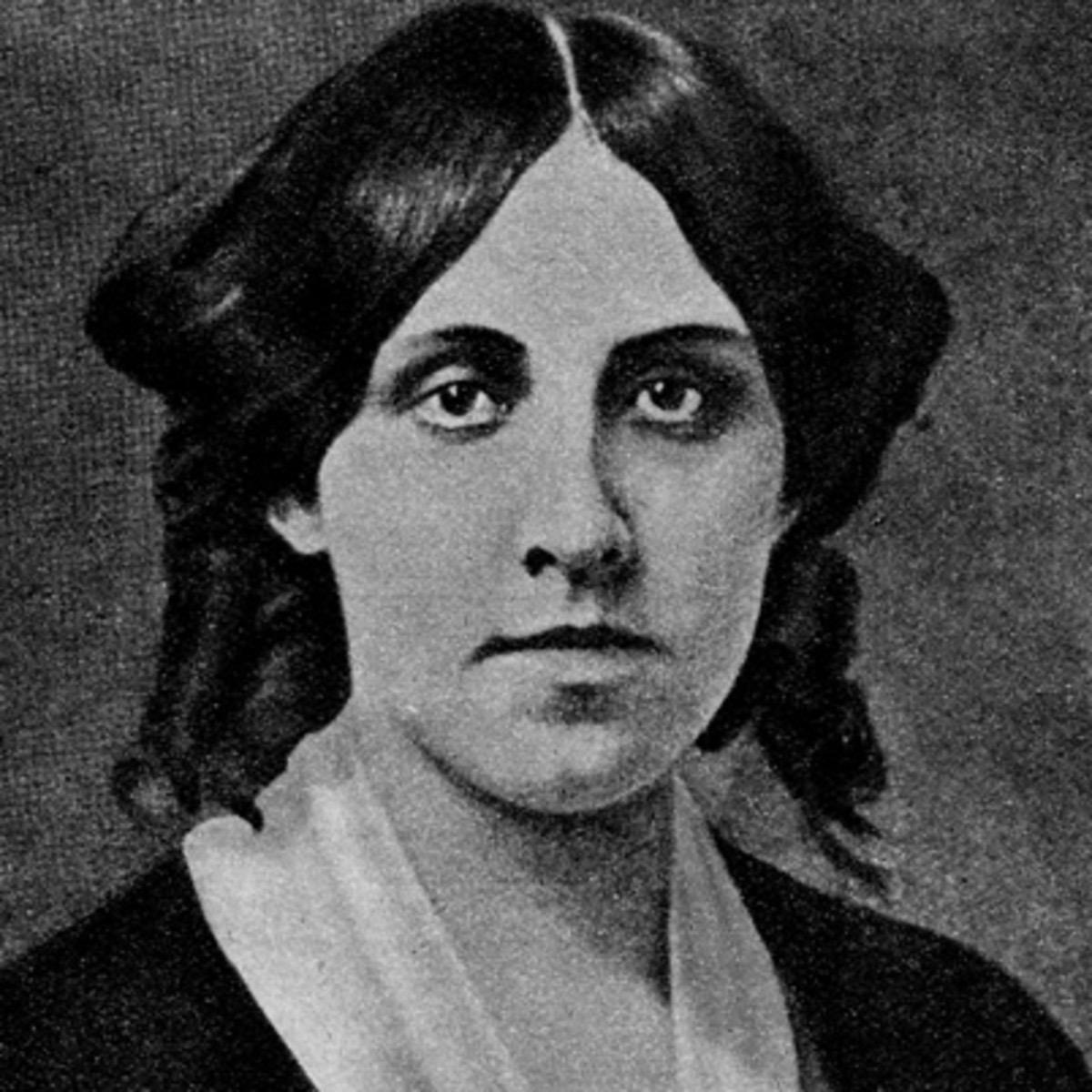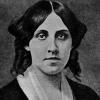Louisa May Alcott was a successful American novelist during the 19th century. While Alcott penned many stories during her career, she is most fondly remembered for her novel Little Women (1868, 1869), which tells the story of the four March sisters as they come of age in Concord, Massachusetts during the Civil War. The tale of Meg, Jo, Beth, and Amy March has become an American classic. Little Women is so distinctive and beloved because Alcott takes a romanticized view of childhood and combines it with the complex realities of life to create an emotional, entertaining, and thought-provoking novel. However, Alcott does teach moral lessons throughout the novel: self worth, self-respect, and independence. Alcott can call back to the literary traditions of the past with her nuanced version of didacticism while also creating a charming and enticing story with strong female characters that pave the way for future female protagonists.
Headshot of Louisa May Alcott at age 20, photo taken circa 1852, Wikipedia.
The photo above was taken of Lousia May Alcott at age twenty in 1852, sixteen years before Little Women was first published. Little Women, now a classic and a pop culture phenomena, has been made for the screen with the most recent adaptation in late 2019.
Jessie Willcox Smith, "And They All Drew to the Fire," for Little Women (1868, 1869), by Louisa May Alcott, 1915 edition, personal library of Catherine J. Golden.
Alcott's own life and family were her inspiration when she wrote Little Women. Alcott was the second oldest of her sisters Anna, Elizabeth, and Abigail May. As seen in the illustration from the 1915 edition by Jessie Wilcox Smith, the fictional sisters were just as close as their fictional counterparts. The oldest sister Anna was the inspiration for Meg March. Anna was considered a talented actress but ended up settling down and marrying to escape poverty. Elizabeth, who tragically died at age 22 of scarlet fever, was the inspiration for Beth March. The youngest Alcott sister, Abigail May, was an ambitious artist like her book counterpart, Amy. Lousia tailored the book's heroine, Jo March, after herself. Like Jo, Alcott was highly outspoken, independent, ambitious, and creative. By using her own life and experiences in her novel, Alcott created an equally entertaining and realistic tale while also communicating her own experiences and values to her audience to both educate and entertain them. She makes her characters feel like real, well-rounded people with flaws to overcome. She romanticizes childhood to a certain extent to keep the reader engaged, but she also adds shades of darkness and realism. These darker moments cause the reader to become more emotionally involved and teach important lessons while introducing the reader to new experiences such as grief and death. Since the primary audience for Little Women was children, one could argue that by making Beth die, just like her real-world counterpart, Alcott is introducing the children to an essential part of life--death.
Frontispiece and Title Page for The Pilgrim's Progress, by John Bunyan (1678), 1815 edition, The British Library.
In Little Women, Alcott references didactic texts while also creating her version of didacticism. For example, Marmee gives each March sister her copy of Pilgrim's Progress (1678, 1684), a classic didactic text by John Bunyan. The March girls love the book, and they pretend to recreate the journey to the celestial city. This example shows how, while Alcott includes some subtle didacticism in her novel, she makes it playful instead of dreadfully serious, like most didactic texts. Alcott creates her own more relaxed form of instruction that teaches women more progressive values than morals. For example, Marmee does not want her daughters to wear corsets, which was very progressive for the time. Marmee also appreciates and encourages her daughters in their passions and goals and does not force them to conform to what society believes that a woman should be. Alcott also teaches about independence through the character of Jo, who asserts herself as an independent person, which was unique for a female protagonist of the time. Jo shows her independence by going to New York alone, cutting and selling her hair when Marmee needs money to take care of Father March in Washington, and refusing Laurie's marriage proposal. Throughout the novel, Alcott uses the character of Jo to show that women can be independent and self-sufficient, teaching her target audience of primarily young girls that they, too, could claim their independence and have an agency like Jo. Finally, Little Women introduces fundamental life concepts such as death to its young readers through the character of Beth. Beth's death is heartbreaking; she is one of the kindest characters to ever be written, and readers cannot help but feel that they are grieving their own loved one. By reading about how the March sisters overcome their beloved sister's death, the reader can learn how to deal with grief and overcome it. While still referencing older didactic texts like Bunyan's, Alcott uses her characters and plot points to introduce readers to important themes such as death and promote female agency.
Frank T. Merrill, "If I Was a Boy, We'd Run Away Together," for Little Women (1868, 1869), by Louisa May Alcott, 1880 edition, personal library of Catherine J. Golden.
While Little Women is an instructional text in its own right, it is also very enjoyable and serves as the gateway book between strictly didactic children's books to more entertaining ones. Each of the sisters has her own fully fleshed out story arc, and all of the side characters in the novel also have rich stories. Characters like Jo March, for example, are the antithesis to the female characters in the didactic work of Mary Martha Sherwood. Jo is wild, headstrong, creative, passionate, and unapologetically independent. Frank T. Merrill portrays these characteristics in his illustration of her shanking her head and lamenting she is not a boy. Jo March opens the door for later spirited female protagonists, such as Anne Shirley Cuthburt from Anne of Green Gables. Little Women is also so entertaining because there is something for everyone--love and romance, struggle, sisterhood, friendship, and family--making it very enjoyable for audiences of all ages throughout the centuries. With such beloved characters like Jo March and with such a classic, entertaining story, Little Women has stayed relevant today.





